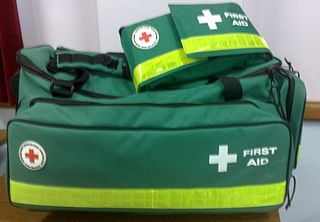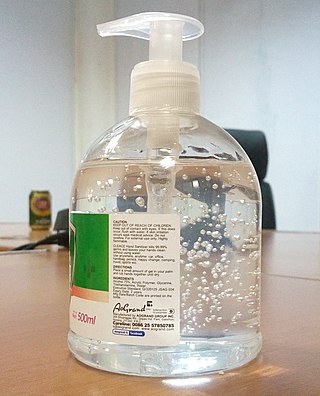Related Research Articles

Mouthwash, mouth rinse, oral rinse, or mouth bath is a liquid which is held in the mouth passively or swirled around the mouth by contraction of the perioral muscles and/or movement of the head, and may be gargled, where the head is tilted back and the liquid bubbled at the back of the mouth.
An antiseptic is an antimicrobial substance or compound that is applied to living tissue to reduce the possibility of sepsis, infection or putrefaction. Antiseptics are generally distinguished from antibiotics by the latter's ability to safely destroy bacteria within the body, and from disinfectants, which destroy microorganisms found on non-living objects.

A first aid kit or medical kit is a collection of supplies and equipment used to give immediate medical treatment, primarily to treat injuries and other mild or moderate medical conditions. There is a wide variation in the contents of first aid kits based on the knowledge and experience of those putting it together, the differing first aid requirements of the area where it may be used, and variations in legislation or regulation in a given area.

Lidocaine, also known as lignocaine and sold under the brand name Xylocaine among others, is a local anesthetic of the amino amide type. It is also used to treat ventricular tachycardia. When used for local anaesthesia or in nerve blocks, lidocaine typically begins working within several minutes and lasts for half an hour to three hours. Lidocaine mixtures may also be applied directly to the skin or mucous membranes to numb the area. It is often used mixed with a small amount of adrenaline (epinephrine) to prolong its local effects and to decrease bleeding.
Abbott Laboratories is an American multinational medical devices and health care company with headquarters in Abbott Park, Illinois, United States. The company was founded by Chicago physician Wallace Calvin Abbott in 1888 to formulate known drugs; today, it sells medical devices, diagnostics, branded generic medicines and nutritional products. It split off its research-based pharmaceuticals business into AbbVie in 2013.

Benzalkonium chloride, also known as alkyldimethylbenzylammonium chloride (ADBAC) and by the trade name Zephiran, is a type of cationic surfactant. It is an organic salt classified as a quaternary ammonium compound. ADBACs have three main categories of use: as a biocide, a cationic surfactant, and a phase transfer agent. ADBACs are a mixture of alkylbenzyldimethylammonium chlorides, in which the alkyl group has various even-numbered alkyl chain lengths.

Chlorhexidine is a disinfectant and antiseptic with the molecular formula C22H30Cl2N10, which is used for skin disinfection before surgery and to sterilize surgical instruments. It is also used for cleaning wounds, preventing dental plaque, treating yeast infections of the mouth, and to keep urinary catheters from blocking. It is used as a liquid or a powder. It is known by the salt forms: chlorhexidine gluconate (chlorhexidine digluconate) and chlorhexidine acetate (chlorhexidine diacetate).

Merbromin is an organomercuric disodium salt compound used as a topical antiseptic for minor cuts and scrapes and as a biological dye. Readily available in most countries, it is no longer sold in Switzerland, Brazil, France, Iran, Germany, Denmark, or the United States due to its mercury content.

Perrigo Company plc is an American Irish–registered manufacturer of private label over-the-counter pharmaceuticals, and while 70% of Perrigo's net sales are from the U.S. healthcare system, Perrigo is legally headquartered in Ireland for tax purposes, which accounts for 0.60% of net sales. In 2013, Perrigo completed the sixth-largest US corporate tax inversion in history when it reregistered its tax status to Ireland to avoid U.S. corporate taxes. Perrigo maintains its corporate headquarters in Grand Rapids, Michigan, within Michigan State University's Grand Rapids Innovation Park.

Hand sanitizer is a liquid, gel or foam generally used to kill many viruses/bacteria/microorganisms on the hands. In most settings, hand washing with soap and water is generally preferred. Hand sanitizer is less effective at killing certain kinds of germs, such as norovirus and Clostridium difficile, and unlike hand washing, it cannot physically remove harmful chemicals. People may incorrectly wipe off hand sanitizer before it has dried, and some are less effective because their alcohol concentrations are too low.

Dial is an American brand of soap, body wash and hand sanitizer manufactured by Henkel North American Consumer Goods, the American subsidiary of Henkel AG & Co. KGaA. It was the world's first antibacterial soap.

Emedastine (trade name Emadine) is a second generation antihistamine used in eye drops to alleviate the symptoms of allergic conjunctivitis. It acts as a H1 receptor antagonist. It works by blocking the action of histamine that causes allergic symptoms. It is used in form of the difumarate. The emedastine difumarate is a white, crystalline, water-soluble fine powder. Emedastine eye drops is usually applied twice a day to the affected eye. When the patients with allergic conjunctivitis were treated with 0.05% emedastine difumarate ophthalmic solution for six weeks, the signs and symptoms such as redness, itching and swelling of the eyes were relieved. Emedastine appears to be devoid of effects on adrenergic, dopaminergic and serotonin receptors. This drug was developed by Alcon, which is global medical company specializing in eye care products.

Benzethonium chloride, also known as hyamine is a synthetic quaternary ammonium salt. This compound is an odorless white solid, soluble in water. It has surfactant, antiseptic, and anti-infective properties, and it is used as a topical antimicrobial agent in first aid antiseptics. It is also found in cosmetics and toiletries such as soap, mouthwashes, anti-itch ointments, and antibacterial moist towelettes. Benzethonium chloride is also used in the food industry as a hard surface disinfectant.
Lucky Core Industries Limited, previously known as ICI Pakistan Limited, is a Pakistani chemical company which is based in Karachi, Pakistan. It manufactures polyester, pharmaceutical, agrochemical, soda ash and animal health products.

Lysol is a brand of American cleaning and disinfecting products distributed by Reckitt, which markets the similar Dettol or Sagrotan in other markets. The line includes liquid solutions for hard and soft surfaces, air treatment, and hand washing. The active ingredient in many Lysol products is benzalkonium chloride, but the active ingredient in the Lysol "Power and Free" line is hydrogen peroxide. Lysol has been used since its invention in the late 19th century as a household and industrial cleaning agent, and previously as a medical disinfectant.
The University of Utah Research Park, also known as Bionic Valley, is located on the campus of the University of Utah in Salt Lake City, United States. The facility has helped create many businesses based on the work of university scientists over the years. Research Park now houses more than forty companies alongside sixty-nine academic departments and employs more than 7,500 people. The annual in-state productivity of park residents exceeds $550 million.

Bayer AG is a German multinational pharmaceutical and biotechnology company and is one of the largest pharmaceutical companies in the world. Headquartered in Leverkusen, Bayer's areas of business include pharmaceuticals, consumer healthcare products, agricultural chemicals, seeds and biotechnology products. The company is a component of the EURO STOXX 50 stock market index.

A transdermal analgesic or pain relief patch is a medicated adhesive patch used to relieve minor to severe pain. There are many types of analgesic patches based on the main ingredients in the patches. These include patches containing counterirritants, which are used to treat mild to moderate pain, and patches containing opioids such as buprenorphine and fentanyl, used to relieve moderate to severe pain. Fentanyl is often used for opioid-tolerant patients. Nitroglycerin, also known as glyceryl trinitrate (GTN), a medication used for heart failure, high blood pressure, anal fissures, painful periods, and to treat and prevent chest pain, can also be found in patches. Beyond these are patches that contain drugs such as diclofenac and lidocaine and various other drugs. The main purpose of transdermal analgesic patches are to administer drugs in a more viable way to patients, as opposed to oral consumption or intravenous administration such as an injection.
Sudocrem is an over-the-counter medicated cream aimed primarily at the treatment of nappy rash. It contains a water-repellent base ; protective and emollient agents; antibacterial and antifungal agents; and a weak anesthetic. As well as nappy rash, it can also be used to treat eczema, bedsores, minor burns, surface wounds, sunburn and chilblains. It was manufactured by pharmaceutical company Forest Laboratories Europe up until July 2014 when the company was acquired by, and combined with, Actavis plc. On March 17, 2015, Actavis completed the acquisition of Allergan, creating a $23 billion diversified global pharmaceutical company.
Penetration enhancers are chemical compounds that can facilitate the penetration of active pharmaceutical ingredients (API) into or through the poorly permeable biological membranes. These compounds are used in some pharmaceutical formulations to enhance the penetration of APIs in transdermal drug delivery and transmucosal drug delivery. They typically penetrate into the biological membranes and reversibly decrease their barrier properties.
References
- ↑ "Bactine FAQ's". Bactine.com. Bayer HealthCare. 2014. Archived from the original on 26 January 2016. Retrieved 5 August 2019.
- ↑ Galton L (14 May 1950). "A Germ-killer for Your Home" . Parade . Retrieved 5 August 2019– via the Salt Lake Tribune (Salt Lake City UT) and Newspapers.com.
- ↑ Cox J (2008). "Miles Laboratories, Inc.". Sold on Radio: Advertisers in the Golden Age of Broadcasting. Jefferson, N.C.: McFarland & Company. p. 203. ISBN 9780786451760. OCLC 1058520112 . Retrieved 5 August 2019.
- ↑ Lazarus G (25 July 1986). "Miles Undergoing Change of Name". Chicago Tribune . Retrieved 5 August 2019.
- ↑ "Miles Laboratories". Advertising Age. 15 September 2003. Archived from the original on 2017-05-04. Retrieved 2017-09-19.
- ↑ "Company Overview of Bayer HealthCare, LLC, Bactine". Bloomberg L.P. Archived from the original on 6 August 2019. Retrieved 6 August 2019.
- ↑ "WellSpring Pharmaceutical Corporation Acquires Bactine®, the Highly Trusted First Aid Antiseptic Brand" (Press release). Sawaya Partners. PR Newswire. December 17, 2015. Retrieved 5 August 2019.